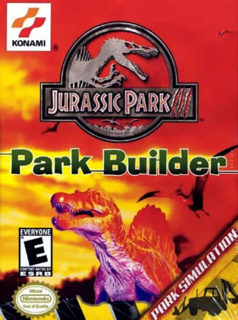The patient gamer who successfully completes the early game will find it both challenging and immersive.
The game focuses on creating a park block by block on a grid system, with roads for bus transportation, paths for humans and decorations/businesses. Of particular importance are the bus routes, as the visitors can only view the attractions while riding in a bus. This is the biggest problem with the game and the reason behind the lengthy learning curve: any dinosaurs/animals that aren’t directly adjacent to a bus-accessible road block are utterly useless. The dinosaurs themselves cost a ton to maintain, as their pens are gradually reduced according to their strength/size and they are prone to diseases/sickness. As shops and other businesses are essential in accumulating the funds required to maintain the dinos, walking paths are needed, and rotaries are needed to unload the people. The busses seem to have a hard time figuring out the road paths themselves, however, and the roads leading up to the rotaries will often prove ineffective if they are not carefully planned out.
Once your park is built up, you must run advertisements on various mediums to attract the type of guest you want (boys, girls, women, or men). The crowds that fill your park all have their own thoughts about the park, such as “The busses are always late”. Sorting these opinions is made easy by management menus that give you the percentage of people supporting each opinion.
You start out with 3-4 prehistoric animals/dinosaurs and must send out expeditions to collect amber from various locations around the globe. Areas that have more popular or abundant dinosaurs cost more to send expeditions to, so there is some strategy involved in deciding where to collect the amber. Regardless of where you send them, however, they will return with complete or partial DNA samples from that region. Each DNA sample has five parts, and when you have collected all five parts of a particular sample, you can use that DNA to form an egg of that dinosaur. This isn’t nearly as tedious as it sounds, as most expeditions return with 2-3 complete samples of DNA. The game has a multiplayer trading component similar to Pokemon wherein two people can trade their DNA samples to one another, adding a ‘collect em’ all’ element to the game.
The graphics in the game are average at best in-game, with all the sprites performing their jobs moderately. The real eye candy lies in the data files for each of the dinosaurs you have identified (created an egg for), each of which contains a high resolution image of the species. The pictures are of astounding quality, and while they are just still shots, give you reason to pride yourself for your purchase of your GBA/DS.
The sound in the game is, unfortunately, not up to the level of graphical quality. The same track loops in the background throughout both the game AND the menu screen, and the people themselves remain silent throughout the game, as do the dinosaurs. An occasional ring-tone announces important information along with a pop-up dialog box, but most gamers will turn off their sound in fear of restless nights or incessant humming of the too-familiar tune.
The Game features only a single save-slot, but new parks can be created without deleting this file (despite the games notice that says otherwise). The hunt for dino DNA is addicting, and the park management is challenging enough to keep even the most seasoned of gamers on their toes. At just $15 used (EB games/GameStop), Park Builder is more than worth the money for any dino or tycoon fan seeking a challenge.

